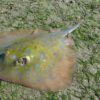Scientists have been able to demonstrate that graphene nanostructures can be generated by annealing of a nanostructured silicon carbide crystal for a few years. “These two-dimensional, spatially strongly restricted carbon bands exhibit a vanishingly small electrical resistance even at room temperature. They are thus ballistic,” explains Prof. Dr. Christoph Tegenkamp, Head of the Professorship of Solid Surfaces Analysis at Chemnitz University of Technology. Something similar does not happen, for example, with an expanded and perfectly two-dimensional layer of graphene.
Physicists at Chemnitz University of Technology, working together with researchers from Eindhoven University of Technology (Netherlands), the Max Planck Institute in Stuttgart, and the MAX IV Laboratory in Lund (Sweden), succeeded in a better understanding of this quantum effect. “We could verify the exact structure of these so-called nanoribbons for the first time with help of an extremely high-resolution transmission electron microscope,” reports doctoral student Markus Gruschwitz from the Professorship of Solid Surfaces Analysis. Thi Thuy Nhung Nguyen, who is also completing her doctoral studies in this area, adds, “Together with measurements from the scanning tunneling microscope, the particular quantum state of this system could now be localized and spectroscopized with high resolution.”
It is important for a theoretical description of the electronic structure that the edge of the graphene nanostructure has a bond to the substrate and the bending induced by this causes a so-called strain effect. Using this model, it was also possible to explain the spin polarization of the migrating electrons. “This bending of the graphene structure has an effect similar to that otherwise found only in materials with strong spin-orbit coupling. Interestingly, graphene itself has a vanishingly small spin-orbit interaction,” Tegenkamp says.
The research results were presented in the current issue of Nano Letters. The authors of the study are certain that the exploitation of defined curvatures will give rise to new functionalities in supposedly trivial structures and materials, and that the research field of straintronics will become further established.
Spin-galvanic effect in graphene with topological topping demonstrated
More information:
Thi Thuy Nhung Nguyen et al. Topological Surface State in Epitaxial Zigzag Graphene Nanoribbons, Nano Letters (2021). DOI: 10.1021/acs.nanolett.0c05013
Provided by
Chemnitz University of Technology
Citation:
Tracking topological conditions in graphene (2021, April 19)
retrieved 19 April 2021
from https://phys.org/news/2021-04-tracking-topological-conditions-graphene.html
This document is subject to copyright. Apart from any fair dealing for the purpose of private study or research, no
part may be reproduced without the written permission. The content is provided for information purposes only.


